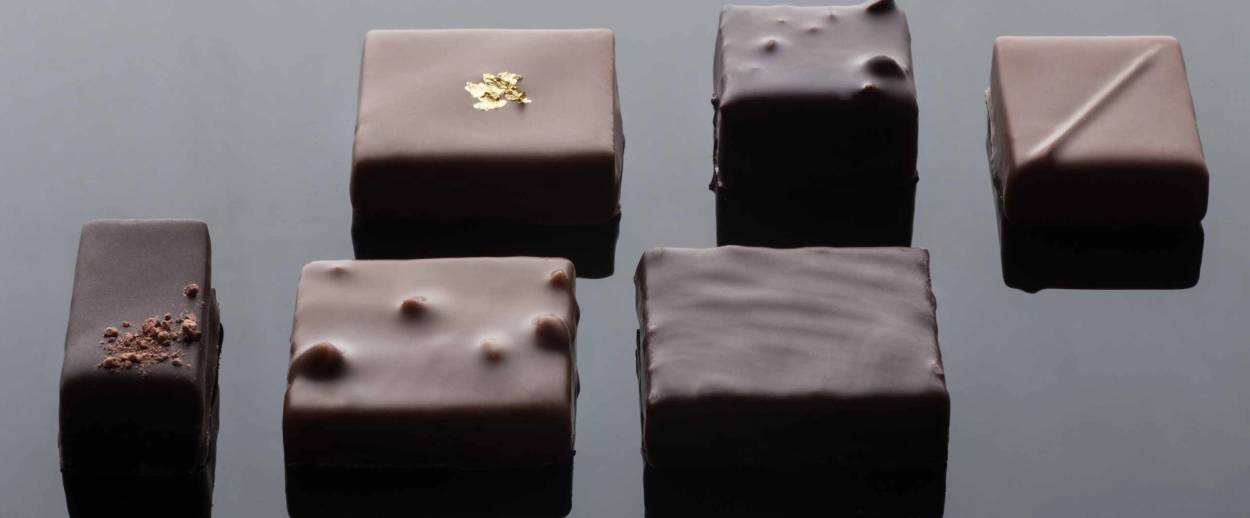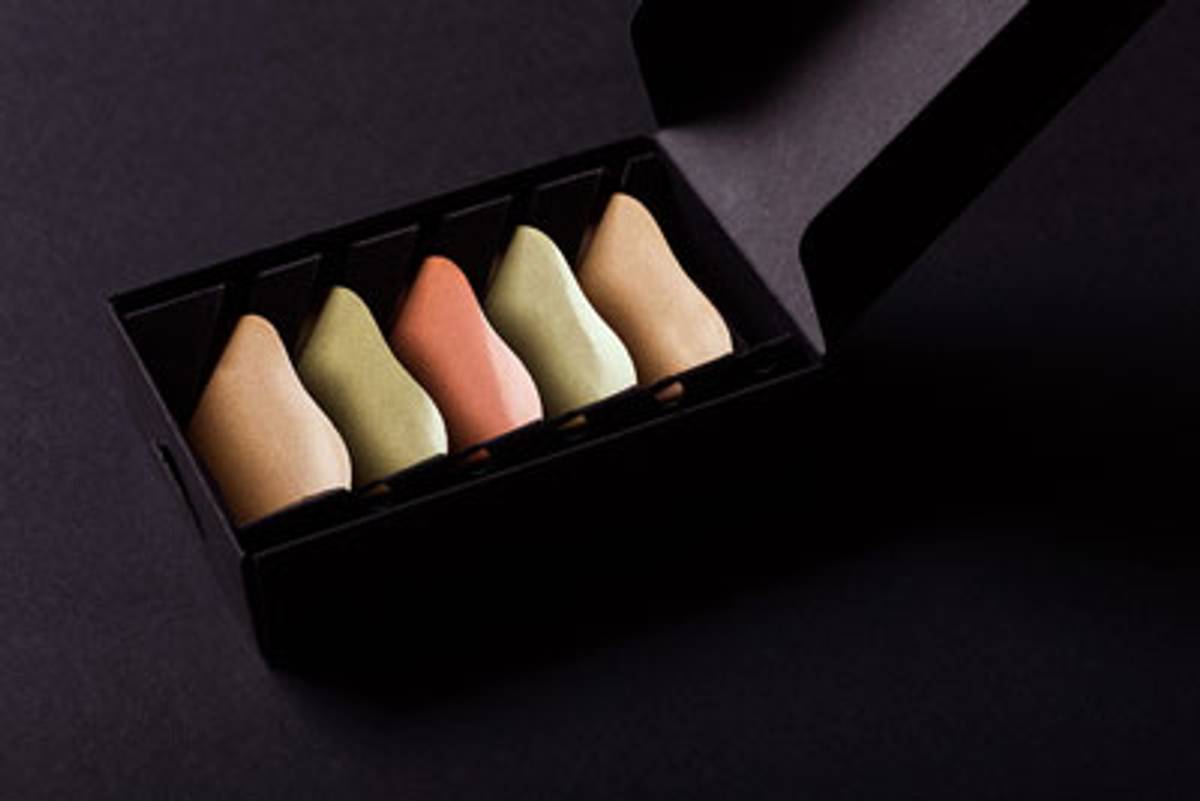The Land of Milk and Chocolate
Israel’s finest chocolatier makes bonbons worthy of the French—in flavors that are pure Israeli




Last January, at the end of a very long, very ambitious dinner cooked for a group of jetlagged visiting culinary luminaries at the Tower of David, a 14th-century citadel in Jerusalem’s Old City, something extraordinary happened: There was room for dessert.
As the overfed guests made their way from the dinner table to the exit, a tableau that would be called gluttonous if it wasn’t so elegant intercepted them. Mounds of assorted bonbons—rochers, shiny multicolored chocolates and regular old chocolate-colored chocolates, barks, discs and batons painted gold and bronze, and shimmering pâte de fruits—were staged on platters, in boxes, on footed dishes and transparent slabs of acrylic on a long bar, and stretched seemingly forever.
Usually after a multicourse affair (in this case, nine courses, which already included a plated dessert), mignardises, the candies and sweets that end a lavish meal, are often pushed away, ignored, saved for later, or merely nibbled on. But this display of bonbons demanded attention. “I was, truly, stunned by their beauty,” the food writer Ruth Reichl, one of the guests, later told me. “I couldn’t stop taking pictures of them.”
They also ignited a feeding frenzy, as though everyone hadn’t just spent the last few hours eating past the point of comfort. “Did you have the za’atar?” “Is that one Turkish coffee?” “Don’t leave without trying the marzipan!” In fact, some guests didn’t bother waiting until the meal was over to start sampling. “Have you had the halva chocolate?” asked a wide-eyed Reichl, who had pilfered one while the sweets smorgasbord was still being assembled. “Nancy has to try this.” (That would be Nancy Silverton, the celebrated baker, chef, and restaurateur, also present.)

Said halva chocolate was a wafer-thin milk chocolate langue de chat (cat’s tongue in French) that, slender as it was, somehow concealed a luscious sesame cream filling. The Tel Aviv chocolatier Ika Cohen, a 43-year-old with a head of wild blond curls and the maker of the night’s sweets, had created this chocolate specifically for the dinner using Al Arz tahini and halva from Nazareth. It had all the finesse of an excellent French confection, with a flavor that was completely Mediterranean. It was a revelation.
Encountering chocolate of this quality in Israel is, well, a little strange. “It’s not something very natural, to do chocolate in Tel Aviv,” Israeli food writer and television host Hila Alpert later told me. “It’s not the right weather, it’s not the right country for the raw material.” But Cohen, who left a career as a sound technician and trained in France under some of the world’s best chocolate makers—including Jacques Genin, Michel Chaudun, and Patrick Roger—has brought an anachronistic sense of refinement to Israeli chocolate that, according to Alpert, is at odds with the national culinary temperament: “In Israel we do things more sauvage—that is a romantic way of putting it.”
But Cohen is a perfectionist. “I am a chocolate junkie,” Cohen told me one afternoon at Ika Chocolate, her atelier in southern Tel Aviv. She wore a black chef jacket with a voluminous gray scarf wrapped around her neck. Even though it was warm outside, inside, it was cool enough to be sweater weather. “My mom used to wake me up with two cups of hot chocolate in the morning. I would drink it with my eyes closed.”
Cohen remembers one time when her father made the hot chocolate, and she didn’t want it: “My mother said, ‘Why, I teach him the same way?’ It was the same recipe, but different hands that made it. I understood the meaning of the hand already back then.”
With few employees, Cohen is personally involved in everything she creates. It’s not for nothing that she is widely considered to be the best chocolatier in Israel, in a class by herself. “She is implicated in every step of the manufacturing,” said Meier Danon, the founder of Danon Culinary Center in Tel Aviv, who befriended Cohen 15 years ago in Paris. “It is handmade chocolate, and the hand that makes the chocolate is Ika’s.” Cohen produces 30 types of chocolate, and the selection in the store always changes. Flavors she may have on any given day include lemon, rum marzipan, Earl Grey, passion fruit, tonka bean, and coconut. Since her product is kosher, she closes production every Friday before Shabbat.
The minimalist storefront, with blond wood paneling and sunflower yellow walls, is just as big as it needs to be to conduct a small retail operation. The rest of the space is devoted to the factory, a spotless workshop with cement floors, stainless steel surfaces, and equipment for making chocolate. In the store, she proudly displays copies of the French chocolate guide Le Guide des Croqueurs de Chocolat, which Cohen once used to eat her way through France, and in which she is now one of few non-French businesses featured. The association’s vice president, Bérangère Loiseau, says what stood out about Cohen’s chocolates, in addition to her technical prowess, is her unique sensibility. “She made some very bold chocolate, like red grapefruit ganache and basil ganache—these are hard things to do,” Loiseau told me. “The execution was perfect. The ganache were very souple, not too thick, like your body when you are doing gymnastics.”
Cohen also displays some of the certificates she’s won from competitions that she’s participated in over the years, such as the International Chocolate Awards. Though she has won distinctions every year since starting to compete in 2012, her breakthrough may have been the gold medal in 2014 for her za’atar bonbon, made with ganache infused with fresh za’atar leaves. “After mastering the French technique, it was time to do homeland ingredients,” said Cohen. She played with mixing dark and milk chocolates until she got the balance she was looking for—a well-rounded sweet with a clean za’atar flavor and a chocolatey finish.
“The power of her flavors, when you put it into your mouth, you can feel the chocolate, but you can feel in a very clear way the flavor of the za’atar,” said Alpert. “It is almost singing solo.”
Piled up on Cohen’s workspace when I visited was a cache of Japanese candies, including an edible Hello Kitty and some Meiji chocolate-covered almonds. She had just returned from her first Tokyo Salon du Chocolat, a big deal event where the best chocolate makers in the world are invited to sell their wares. Cohen was still stunned by the reception she received. On her first day, she sold nearly three days’ worth of chocolates. The lines of people queuing for them were relentless, and she sold out in under three hours on most days. “The fact that ‘ika’ is ‘squid’ in Japanese maybe got them to stop,” she said.
For the Tokyo Salon du Chocolat, Cohen also created a langue de chat, this one with an olive oil and sea salt filling. “They know Dead Sea salt from cosmetics, but not with food,” said Cohen. On one side of the chocolate was a kawaii green olive print designed by illustrators Batia Kolton and Rutu Modan, and they were packed in sleek, matte black boxes worthy of Japan. After her success at the chocolate show, Cohen is looking into selling her chocolates through a distributor in Tokyo. One day, she hopes to sell her chocolate in the United States, too. “People know me better in other countries than they do in my country,” said Cohen. “A camera crew came from India and asked Israel Tourism about Ika Chocolate, and they never heard of me.”
As if on cue, a customer approached Cohen: “Are you Ika? I saw you in the paper.” Cohen asked, “Where are you from?” The customer replied, “From Japan.”
Cohen turned to me. “It’s so amazing,” she said. “They keep coming.”
***
Like this article? Sign up for our Daily Digest to get Tablet magazine’s new content in your inbox each morning.
Gabriella Gershenson is a food writer and editor based in New York City. Find her on Instagram and Twitter @gabiwrites.